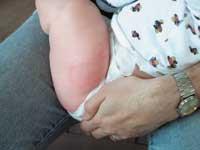Vaccines, protective punctures
Vaccines are prepared with dead, derogated microorganisms, or parts of them. Thus, the body of the vaccinated person launches protection mechanisms against this microorganism, but at the same time it does not have the capacity to provoke the disease.
First vaccination vaccine

XVIII. In the twentieth century smallpox was a deadly disease. In Europe it was often spread in the form of an epidemic and was an endemic disease that caused serious health problems. The English physician Edward Jenner, born in 1749, found that farmers affected by the type of smallpox that affects cattle were resistant to smallpox.
In addition, cattle disease caused humble symptoms in the human being, while resistance persisted for many years. Therefore, he did an experiment: he removed the pus from a woman who ran over the disease from milking cows and put a healthy eight-year-old child in the blood. A week later, and for a couple of days, the child only had the beans that disappeared without problems at the puncture site. Then he put the pus of a sick person, but did not develop the terrible disease. Thus, it showed that protection was generated and the use of the vaccine spread rapidly throughout Europe. The name (vaccine) was also received from the disease that affected cows.
However, Jenner was not able to explain how immunity was achieved. Years later, chemist Louis Pasteur declared that the causes of diseases were microorganisms. In addition, Pasteur showed that what Jenner achieved with smallpox could also be done with other diseases, including the introduction in the blood of the attenuated bacteria of antrax, that the disease was not developed and that a long-term protection was obtained.
Body protection system
Although the value of vaccines was empirically demonstrated, it passed a century until the fundamentals of immunology were known. The truth is that it is such a complex system that there are aspects yet to be resolved. The immune system has numerous mechanisms to combat the causing infections.
Basically there are two types of immunity. The first is the immunity proper to birth. Through many mechanisms, it prevents the entry of foreign bodies or destroys them in the first phases of infection. The other type of immunity is acquired and is put into operation if the foreign agent exceeds its own immunity.

Among the main characteristics of acquired immunity is the detection of foreign elements to the organism. In addition, the strange element has the ability to distinguish one from another and know them specifically, allowing it to respond to each of them. Finally, once the infectious agent is known, it retains its memory, so the response to the next infection will be faster and more effective. All this is possible thanks to the T and B cells of the immune system, as well as the antibodies that produce them.
Immunity acquired from certain diseases is obtained through vaccines. For vaccination against a certain disease, the infectious agent is transformed to lose the capacity to cause virulence or disease. But after the transformation, it preserves the antigenic capacity, that is, to provoke an immune response.
In this way, the organism has prepared its protection mechanisms for the next attack of the infectious agent. Some special B cells (memory cells) retain the memory of the antigen, so they create specific antibodies immediately and extensively, and T cells also multiply when infective agents penetrate the blood. This causes the destruction or inactivation of microorganisms, preventing the development of the disease.
Characteristics of vaccines
Currently, there are two types of vaccines, bacterial and viral, depending on the agent that causes the disease that is intended to be prevented, since a vaccine has not yet been obtained to prevent diseases caused by protozoa or fungi. Examples of bacterial vaccines are the BCG tuberculosis vaccine, against typhoid fever, and the triple DTP vaccine that includes anti-Kukutxeztul, Tetanus and Diphtheria. In contrast, antigrayials, hepatitis B, poliomyelitis and rabies or triple viral vaccine of measles, harcigalas and rubella.

Both antibacteria and viral can be done with live or dead microorganisms. Living beings who lose virulence are abolished, for which they reproduce in appropriate breeding means for them, until the new generations lose their capacity to cause the disease, other times they are genetically altered. In the second case, by physical (heat) or chemical methods (acids and alkali) viruses or bacteria are inactivated. In this way, microorganisms die, but do not lose the structure that causes the immune response.
Other types of vaccines are produced with fragments of microorganisms that can be proteins, lipids, or polysaccharides with antigenic capacity. Due to the need for a complete microorganism to cause the disease, vaccines with their parts do not pose danger. There are also vaccines with bacterial toxins, in which case the toxins are subjected to heat or formaldehyde to lose their toxicity but retain their antigenic capacity.
In addition to antigens, vaccines include stabilizers and antibiotics to prevent their deterioration, an assistant that strengthens the immune response capacity such as aluminum salts and, in the form of excipients, distilled water, salted serum or others.
On the other hand, some vaccines protect from the only infectious agent. Polyvalent vaccines, for their part, face different agents of the same disease, such as the three types of viruses that cause poliomyelitis. When antigens from various diseases are collected in the same vaccine, as in the DTP vaccine, they are called partners. Finally, the simultaneous vaccines are those that, despite being different products, are placed at the same time, even by different ways. For example, contra-poliomyelitis is administered orally and DTP via parenteral, but both are administered simultaneously.
Immunity is not achieved immediately after vaccination, usually lasts for a few months, during which the body produces antibodies against the infectious agent. Therefore, in general, vaccination is a medium-term or long-term preventive measure that is not effective if given after infection. However, there are exceptions such as rabies vaccine. This case is special, since after its introduction the organism takes longer to cause irreversible lesions than in the production of antibodies. Therefore, once the vaccine is contaminated, its application is effective.
Vaccination programmes

The immunity obtained by vaccines is not definitive, since the number of antibodies left in the blood after a few years is not enough to fight the infection. Consequently, for the maintenance of immunity, vaccines must be administered more than once and, depending on the type of vaccine, a schedule of vaccination is made that includes the commemorative doses. The calendar is set between 14 and 16 years from newborns.
Vaccinations are carried out with two main objectives: to protect individuals from common or severe infectious diseases, and to reduce their incidence and extent within society, by reducing the number of patients, reducing the risk of contagion.
Although specific vaccination programmes are in the hands of each community, the recommendations of the WHO are followed on a global level. In the immunization program carried out in 1974, this organization proposed to reduce the morbidity and mortality of the six diseases that mainly affect children through vaccines: poliomyelitis, measles, diphtheria, pertussis, tetanus and tuberculosis. On May 8, 1980, it was two years since the last case of smallpox was diagnosed, so the WHO declared its eradication and the vaccination campaign against this disease was suspended.
Asking for the opinion of several pediatricians of Osakidetza, they wanted to make it clear that to prevent infectious diseases you can not do without them. In fact, although in some cases the protection offered by vaccines is very useful, we must not forget other important factors that affect the development of diseases.
Vaccines have allowed the domain of serious diseases that were previously frequent. Along with this, since there are currently adequate treatments to cure some of these diseases, it is not necessary that in all cases all vaccines are given and more attention is paid to other agents.

The child's well-being and lifestyle greatly influences his or her immune system. On the one hand, an adequate diet, healthy habits and a physical exercise that helps you to stay strong. On the other hand, a good psychological state also benefits and protects more from diseases. Therefore, much attention should be paid to those times when the child can feel weak, such as when he starts school, when the parents are going to separate, or if he has had another brother. At that time it has a higher risk of getting sick, so to prevent it, care must be taken for the affectivity of the child and teach him to overcome frustrations. In short, in the prevention of diseases, in addition to vaccination, there are many other aspects to consider.
In addition, in some cases, we should question whether it is worth vaccinating, and before making the decision, we must take into account both the history of the child's environment and the number of patients in the population. For example, the increase in cases of tuberculosis decades ago caused the EEA vaccination calendar to include BCG, which is now the only community in the Spanish state that gives this vaccine. But this vaccine has a number of disadvantages: it is an old vaccine that protects only from the most serious types of tuberculosis and can produce false positives in the diagnosis of the disease. Therefore, if there has been no tuberculosis among relatives and the child does not have to live in a place of special risk, it may not need to be vaccinated.
Other vaccines, such as tetanus and diphtheria, can be fully recommended. Both diseases are caused by bacterial toxins, so although all children in the area are vaccinated, the bacteria will remain there and unvaccinated children can get sick with toxins.
On the other hand, some doctors consider that massive vaccinations overforce the immune system and cause errors, thereby increasing the risk of autoimmune diseases. According to some studies, development of celiac disease, some degenerative diseases and different types of diabetes may be related to vaccines. In addition, some vaccines are at risk of causing serious side effects, while others remain protected in the short term and require periodic reintegration.
With these examples, these pediatricians want to make it clear that the characteristics of the child and the vaccine must be taken into account. Parents have the last word and have the right to receive all the information so that the decision is responsible.
The immunization obtained through vaccines is called active because the protection mechanisms put them in the body. In passive immunization, certain antibodies (immunoglobulins) or activated T cells are injected directly. Consequently, protection is immediate, but has a maximum duration of two or three weeks. They are used to cure more than to prevent diseases and can come from humans or animals who have passed or have been vaccinated. |





